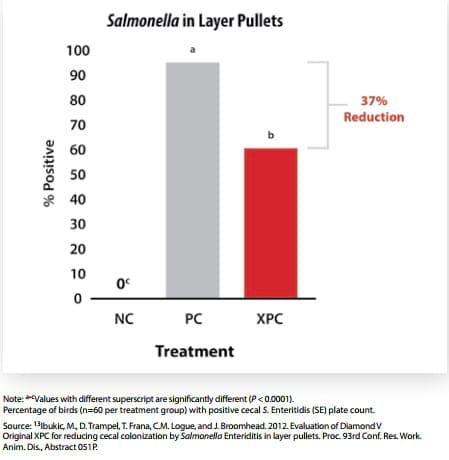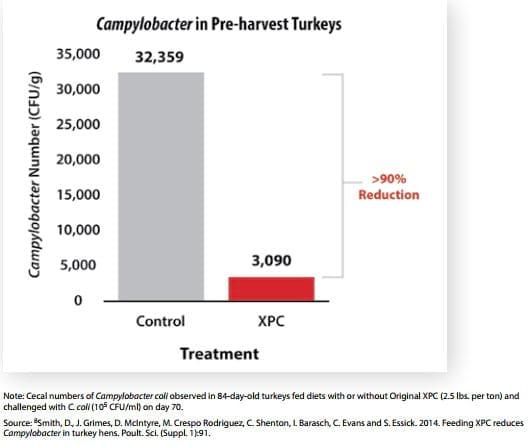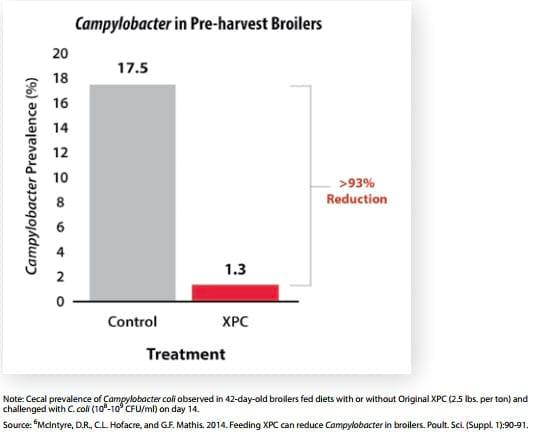Pre-harvest reduction of foodborne pathogens in food animals
Published: September 3, 2015
By: Doug Smith ; Stephanie Frankebach
Diamond V's unique, all-natural products, resulting from more than 70 years of scientific research and development, offer unmatched benefits and solutions for food animal production. As published in over 125 peer-reviewed scientific journal articles, the pre-harvest technologies of Diamond V products promote immunity, animal health, and human food safety while optimizing performance of poultry, pigs, dairy and beef cattle, aquaculture species, and other food animals.
PART 1
Pending Patent: Foodborne Pathogen Reduction
Diamond V recently announced the patent-pending use of Diamond V Original XPC™ (XPC) as a "method for foodborne pathogen reduction in livestock." As described in the pending patent, feeding XPC throughout food animal production resulted in reduced prevalence and numbers of Salmonella and Campylobacter in poultry, as measured in the animal, production environment, and processing plant. Additional research conducted in other species has shown that Diamond V technology supports optimal immunity, health, and performance when animals are challenged with foodborne pathogens.
Jeff Cannon President & CEO, Diamond V
"Our industry-leading research and 'first in the field' patent pending pre-harvest pathogen reduction applications give producers and consumers confidence that Diamond V technologies and expertise help provide additional security from food safety challenges."
Healthy animals are critical to food safety, security, affordability, and quality. Pre-harvest control of foodborne pathogens enhances animal wellness, animal welfare, and product safety prior to processing.
Use of Diamond V technology, including XPC, benefits food animal production and the food industry in multiple ways:
- Improved pre-harvest food safety;
- Improved animal health and welfare;
- Improved producer and food company sustainability and profitability;
- Greater efficacy in antibiotic-free production systems; and
- Greater animal production efficiency.
PART 2
Increased Food Safety Concerns
Food safety has increased as a priority for federal and state regulatory agencies. Significant changes in federal food safety and feed production regulations have occurred with the passage of the U. S. Food Safety and Modernization Act. Activity at the state level has involved the passage of labeling laws and animal care legislation.
Jeff Cannon President & CEO, Diamond V
"Recent food safety issues have received attention in many parts of the world. It has been a source of pride that Diamond V has provided solutions to pre-harvest food safety challenges for decades. Our all-natural products help to improve the nutritional and health status of food animals, helping them to fend off challenges that can lead to problems in the food supply chain."
Despite significant progress by the poultry and red meat industries in reducing foodborne pathogens, the rates of human illness persist. Pathogenic bacteria such as Salmonella, Campylobacter, and Escherichia coli are frequently associated with consumption of animal protein products, and are often cited among the top five pathogens causing foodborne illness in the U.S.15,19 Companies producing foods of animal origin must implement effective pre-harvest food safety programs in order to lower the risk of human illness.

Responsibility for foodborne pathogen control (e.g., Salmonella, Campylobacter, etc.) lies within each link in the food chain, from farm to fork, in order to produce a safe, sustainable, and abundant food supply. Research-proven technologies must be key components in a company's food safety plans.
PART 3
Direct Correlation: Pre-Harvest and Post-Harvest Contamination
Research shows that the pre-harvest pathogen contamination of animals, especially poultry, correlates directly with the post-harvest presence of pathogens found in the processing plant and in food products. 8, 12, 14, 18, 20, 21, 22, 23, 24
Many efforts to reduce pathogen numbers in food animals and products, including chemicals applied during processing, are not completely effective. Furthermore, chemicals used during processing are expensive and may have unintended effects.
While there is no "silver bullet" to completely eliminate foodborne pathogens, a multi-step food safety program, including pre-harvest mitigation at the farm level, has been shown to be most effective.
PART 4
Pending Patent: Supporting Research
Diamond V's pending patent is based on numerous studies conducted at many research institutions that considered the challenges posed by several different strains of Salmonella and Campylobacter. The resulting body of scientific knowledge on the effects of XPC on foodborne pathogen reduction represents the largest known collection of pre-harvest research projects. These projects are the replicable work of leading investigators at various research locations using varying methods. The quality, consistency, and reliability of these multiple sources of data further support Diamond V's unique pending patent.
Research detailed in the pending patent has demonstrated that feeding XPC to egg laying hens, meat-type chickens, and turkeys helped reduce the prevalence of Salmonella and Campylobacter isolated from birds and their environment. Research also found that numbers of both Salmonella and Campylobacter isolated from positive birds were reduced.
The patent-pending use of XPC, described below, introduces technology vital for the food industry today and for the foreseeable future. XPC provides an effective, all-natural approach to improve the safety and quality of poultry, eggs, pork, beef, fish, and milk by helping reduce incidence, colonization, and shedding of foodborne pathogens.
Listed below are brief summaries of research studies described in Diamond V's pending patent "Method for Foodborne Pathogen Reduction in Livestock."
Reduced Salmonella numbers
Addition of XPC in feed helps result in reduced Salmonella numbers or load in poultry, as summarized below:

A. Sixteen houses of broilers were commercially grown with or without XPC and slaughtered at approximately 46 days of age. At processing, carcass rinse at rehang was sampled from 25 birds per house. The Salmonella number (load) detected on the Salmonella-positive carcass of the XPC-fed bird (n = 1) was numerically less at 2.20 log10 (log) MPN (most probable number), compared to the average of 2.43 log MPN per carcass for control birds (n = 17), equal to approximately 40% reduction of Salmonella.1
B. Commercial turkey toms were raised to 20 weeks of age and fed XPC or control diets and ceca were collected in the processing plant. The mean Salmonella number of the culture-positive samples was 0.43 log lower in XPC-fed birds compared to controls (P = 0.017), which equaled more than 60% reduction of Salmonella. 1
C. XPC helped significantly suppress (P < 0.05) the growth of Salmonella in broilers fed antibiotic-free commercial broiler diets (0-42 days), with and without the addition of XPC, resulting in Salmonella reduction of more than 99%.2
D. In an in vitro broiler chicken intestinal model system, XPC reduced Salmonella Enteritidis 3 logs by 24 hours in comparison to the control culture without XPC, amounting to reduction of more than 99%.3
E. Using cecal content from 6 week old broilers, XPC helped provide a rapid inhibition of S. Typhimurium that was significantly reduced (P < 0.05) by more than 3 logs compared to the Salmonella colony forming units per milliliter (CFU/ml) in the control culture (feed + cecal contents), which was equivalent to more than 99% reduction of Salmonella. 3
F. Pen-raised turkey hens inoculated with S. Typhimurium at 1 day of age and S. Heidelberg at 56 days of age and fed XPC had significantly lower (P < 0.05) average MPN of Salmonella compared to hens fed control diets (1.1 vs. 2.9 log, respectively) when processed at 84 days, amounting to 98% reduction.42
G. XPC helped significantly suppress (P < 0.001) the growth of S. Arizonae in turkeys by 0.5 log compared to the control, resulting in Salmonella reduction of nearly 70%.10
H. S. Heidelberg growth was significantly suppressed (P < 0.001) by 0.4 log, or about 60%, in an in vitro poultry model compared to the control treatment without XPC inclusion.10
I. Growth of S. Enteritidis CFU was significantly suppressed by more than 1 log, or greater than 90%, by the addition of XPC to fecal inoculant derived from hen excreta (P < 0.001) in an in vitro poultry intestinal model.11
J. Floor pen-raised pullets fed XPC had significantly lower S. Enteritidis numbers (about 87% reduction) in the ceca at 34 days compared to control pullets (3.6 vs. 4.5 log CFU, respectively; P < 0.0001).13
Reduced Salmonella prevalence — carcass rinse
Addition of XPC in feed helps result in reduced Salmonella prevalence, as measured in the poultry processing plant:
- Commercial broiler chickens fed XPC (2.5 lbs. per ton) had lower prevalence of Salmonella (natural challenge) than broilers fed a diet without XPC. Broilers were slaughtered at a commercial plant at 46 days and 25 carcasses per house were rinsed at rehang (between defeathering and evisceration) for Salmonella evaluation. Control broiler carcasses were 8.5% positive for contamination (17/200) while XPC-fed birds were significantly lower (P = 0.011), with only 1 bird testing positive (0.5%).1

Reduced Salmonella prevalence — cecum
Addition of XPC in feed produced research results showing reduced Salmonella prevalence, as measured in poultry ceca samples:
- Prevalence of cecal Salmonella (natural challenge) in XPC-fed broilers raised in floor pens was approximately 8%, which was significantly lower (P < 0.05) compared to control-fed broiler ceca (19%) at 42 days of age.2
- Sixteen houses of commercially grown and processed turkey toms, slaughtered at approximately 20 weeks of age, had a significantly lower (P = 0.014) Salmonella prevalence in the ceca when XPC was fed (2.5 lbs. per ton), with a detection of 41.7% positives (83/200), versus the control toms at 66.5% positives (133/200).1
- Floor pen-raised pullets fed XPC had significantly lower ceca prevalence of S. Enteritidis at 34 days compared to control pullets (60% vs. 95%, respectively; P < 0.0001).13

Reduced Campylobacter numbers — cecum
Unprecedented research, as described in the pending patent, suggests pre-harvest implementation of XPC may significantly reduce Campylobacter numbers in poultry:
- Cecal contents were evaluated from broiler chickens raised in pens 0-42 days and challenged with Campylobacter coli (C. coli) on day 14. Broiler chickens fed XPC had a lower MPN than the control birds (0.94 and 37 MPN, respectively; P = 0.09).6
- Turkey hens inoculated with C. coli had significantly (P < 0.05) lower Campylobacter numbers in the ceca at 84 days of age when fed XPC (3,090 CFU/g), compared to hens not fed XPC (32,259 CFU/g). C. coli was reduced by 1 log (from 4.5 to 3.5) for XPC-fed turkey hens when compared to control hens.8

Reduced Campylobacter prevalence — cecum
Research findings suggest pre-harvest use of XPC also may significantly reduce Campylobacter prevalence in poultry:
- Cecal contents from broiler chickens challenged with C. coli and fed XPC had significantly lower C. coli prevalence than challenged birds fed a control diet (1.3% vs. 17.5%, respectively; P = 0.02).6

- Turkey hens inoculated with C. coli had significantly (P < 0.05) lower prevalence in the ceca at 84 days of age when fed XPC, compared to hens not fed XPC. Pathogen prevalence was significantly (P < 0.05) reduced in non-inoculated birds (exposed to horizontal transmission) from 93% to 75%, for XPC-fed turkey hens when compared to control hens.8
Increased volatile fatty acid production
Research findings suggest feeding XPC increases volatile fatty acid (VFA) levels, specifically butyrate:
- XPC produced a doubling of short chain fatty acids (acetate and butyrate) at 24 hours, compared to control samples in an in vitro poultry intestinal model challenged with S. Typhimurium.3
- VFA levels, especially butyrate, were increased by 300% (P < 0.05) from XPC inclusion compared to controls in an in vitro poultry model challenged with S. Heidelberg compared to the model without XPC inclusion.10
- Turkey inocula treated with XPC had increased (P < 0.05) VFA levels and increased butyrate, compared to control samples in an in vitro poultry intestinal model challenged with S. Arizonae.10
- XPC increased VFA levels, including butyrate, in XPC-treated samples (P < 0.001) in an in vitro poultry intestinal model challenged with S. Enteritidis.11
- SmartCare®, which includes Diamond V Original technology, increased VFA levels, including butyrate, when compared with control in an in vitro dairy calf intestinal model challenged with S. Typhimurium.7
PART 5
Additional Research Findings
Further studies of Diamond V Original products support the pending patent, "Method for Foodborne Pathogen Reduction in Livestock," as summarized below:
DAIRY CALVES
Salmonella Typhimurium challenge
Dairy calves fed Diamond V SmartCare® in the liquid milk replacer and Original XPC in the starter feed, then challenged with S. Typhimurium, had less colonization of intestinal Salmonella and reduced time of Salmonella shedding compared to control calves. Also, calves receiving Diamond V products had significantly (P < 0.05) less diarrhea and fever, rumens that were more developed, and enhanced weight gain compared to calves fed control diets.5
BEEF HEIFERS
Escherichia coli O157:H7 challenge
After a direct challenge with Escherichia coli O157:H7 (E. coli), beef heifers fed either Original XP™ (XP) or a control diet without XP cleared faster and had reduced (P < 0.05) prevalence and numbers of E. coli than control-fed heifers. Measurements included:
- Rumen samples from XP heifers had lower (P = 0.04) E. coli numbers than control heifers;
- Four days post-challenge, all XP heifers were non-detectable for E. coli in the rumen while 2 control heifers were positive;
- Recto-anal swabs showed numbers of E. coli were lower (P = 0.02) after 1 day; and
- Two XP heifers were clear by day 11 post-challenge, while all control heifers remained positive throughout the study.17
PIGS
Salmonella Typhimurium challenge
Young pigs fed a nursery diet with or without Original XPC were challenged with S. Typhimurium. Pigs fed XPC were found to have increased (P < 0.05) populations of beneficial Bacteroidetes and Lactobacillus bacteria in the gut and improved body weight gain after Salmonella infection compared to control pigs.16
References
- Hofacre, C., R. Berghaus, D. McIntyre, and D. Smith. 2015. Field studies: Preharvest Salmonella control using the immune modulator Original XPC in broilers and commercial turkeys. Int. Poult. Sci. Forum Abs. Book. Accessed at http://www.southernpoultrysciencesociety.org/pdfs/2015AbstractBook.pdf
- Roto, S., S.I. Lee, P. Rubinelli, S.H. Park, and S. Ricke. 2015. Cecal Salmonella and indigenous microflora response to Original XPC™-fed broilers. Int. Poult. Sci. Forum Abs. Book, p. 18. Accessed at http://www. southernpoultrysciencesociety.org/pdfs/2015AbstractBook.pdf
- Rubinelli, P.M., S.M. Roto, and S.C. Ricke. 2015. Original XPC™ decreases Salmonella Typhimurium and Enteritidis populations and alters fermentation acid profiles in chicken in vitro cecal incubations. Poult. Sci. 94 (Suppl. 1):155-156.
- Smith, D.P., G.F. Mathis, C.L. Hofacre, R.D. Berghaus, and D.R. McIntyre. 2015. Effect of Original XPC on prevalence and numbers of Salmonella (S.) from ceca of turkey hens inoculated at 1 d of age with S. Typhimurium and at 56 d with S. Heidelberg. Int. Poult. Sci. Forum Abs. Book, p. 13. Accessed at http:// www.southernpoultrysciencesociety.org/pdfs/2015AbstractBook.pdf
- Brewer, M.T., K.L. Anderson, I. Yoon, M.F. Scott, and S.A. Carlson. 2014. Amelioration of salmonellosis in pre-weaned dairy calves fed Saccharomyces cerevisiae fermentation products in feed and milk replacer. Vet. Microbiol. 172:248-255.
- McIntyre, D.R., C.L. Hofacre, and G.F. Mathis. 2014. Feeding XPC can reduce Campylobacter in broilers. Poult. Sci. 93 (Suppl. 1):90-91.
- Nsereko, V., I. Yoon, J. Butler, and A. Brainard. 2014. Effects of SmartCare on fermentation characteristics and growth of Salmonella Typhimurium in a dairy calf IAMM (in vitro model) challenged with Salmonella Typhimurium. Diamond V Research & Innovation Center, Laboratory Research Report (unpublished).
- Smith, D., J. Grimes, D. McIntyre, M. Crespo Rodriguez, C. Shenton, I. Barasch, C. Evans and S. Essick. 2014. Feeding XPC reduces Campylobacter in turkey hens. Poult. Sci. 93 (Suppl. 1):91.
- Berghaus, R.D., S.G. Thayer, B.F. Law, R.M. Mild, C.L. Hofacre, and R.S. Singer. 2013. Enumeration of Salmonella and Campylobacter spp. in environmental farm samples and processing plant carcass rinses from commercial broiler chicken flocks. Appl Environ Microbiol. 79: 4106-4114.
- Nsereko, V.L., J.N. Broomhead, J. Butler, T. Weigand, and E. Gingerich. 2013. Effects of Original XPC on growth of Salmonella Arizonae and Heidelberg in a complex fecal microbial population. Poult. Sci. 92 (Suppl. 1):130.
- Broomhead, J., D. Severson, J. Butler, and J. Frank. 2012. Effects of a Saccharomyces cerevisiae fermentation product on volatile fatty acid production and growth of Salmonella in a complex fecal microbial population in vitro. Poult. Sci. 91 (Suppl.1):132.
- Cox, N.A., L.J. Richardson, J.J. Maurer, M.E. Berrang, P.J. Fedorka-Cray, R.J. Buhr, J.A. Byrd, M.D. Lee, C.L. Hofacre, P.M. O'Kane, A.M. Lammerding, A.G. Clark, S.G. Thayer, and M.P. Doyle. 2012. Evidence for horizontal and vertical transmission in Campylobacter passage from hen to her progeny. J. Food Prot. 75:1896-1902.
- Ibukic, M., D. Trampel, T. Frana, C.M. Logue, and J. Broomhead. 2012. Evaluation of Diamond V Original XPC for reducing cecal colonization by Salmonella Enteriditis in layer pullets. Proc. 93rd Conf. Res. Work. Anim. Dis., Abstract 051P. Accessed at: http://www.abstractsonline.com/Plan/ViewAbstract.aspx?sKey=fc66c2f3- f835-43ef-bdd7-5c10ac72614c&cKey=0346092d-c117-4891-88f1-bd3d25609258&mKey={CDAC4DF3- E5E6-427E-A230-2F588B938865} PART 6
- Hue, O., V. Allain, M.J. Laisney, S. Le Bouquin, F. Lalande, I. Petetin, S. Rouxel, S. Quesne, P.-Y. Gloaguen, M. Picherot, J. Santolini, S. Bougeard, G. Salvat, and M. Chemaly. 2011. Campylobacter contamination of broiler caeca and carcasses at the slaughterhouse and correlation with Salmonella contamination. Food Microbiol. 28:862-868.
- Scallan, E., R.M. Hoekstra, F.J. Angulo, R.V. Tauxe, M.A. Widdowson, S.L. Roy, J.L. Jones, and P.M. Griffin. 2011. Foodborne illness acquired in the United States -- Major pathogens. Emerg. Infect. Dis. 17:1-21.
- Price, K.L., H.R. Totty, H.B. Lee, M.D. Utt, G.E. Fitzner, I. Yoon, M.A. Ponder, and J. Escobar. 2010. Use of Saccharomyces cerevisiae fermentation product on growth performance and microbiota of weaned pigs during Salmonella infection. J. Anim. Sci. 88:3896-3908.
- Liou, L., H. Sheng, W. Ferens, C. Schneider, A. N. Hristov, I. Yoon, and C.J. Hovde. 2009. Reduced carriage of Escherichia coli O157:H7 in cattle fed yeast culture supplement. Prof Anim. Scient. 25:553-558.
- Johannessen, G.S., G. Johnsen, M. Okland, K.S. Cudjoe, and M. Hofshagen. 2007. Enumeration of thermotolerant Campylobacter spp. from poultry carcasses at the end of the slaughter-line. Lett. Appl. Microbiol. 44:92-97.
- Skovgaard, N. 2007. New trends in emerging pathogens. Int. J. Food Microbiol. 120: 217–224.
- Rosenquist, H., H.M. Sommer, N.L. Nielsen, and B.B. Christensen. 2006. The effect of slaughter operations on the contamination of chicken carcasses with thermotolerant Campylobacter. Int. J. Food Microbiol. 108:226-232.
- Corry, J.E.L., V.M. Allen, W.R. Hudson, M.F. Breslin, and R.H. Davies. 2002. Sources of Salmonella on broiler carcasses during transportation and processing: Modes of contamination and methods of control. J. Appl. Microbiol. 92:424-432.
- Heyndrickx, M., D. Vandekerchove, L. Herman, I. Rollier, K. Grijspeerdt, and L. De Zutter. 2002. Routes for Salmonella contamination of poultry meat: Epidemiological study from hatchery to slaughterhouse. Epidemiol. Infect. 129:253-265.
- Corry, J.E., and H.I. Atabay. 2001. Poultry as a source of Campylobacter and related organisms. J. Appl. Microbiol., 90:96S-114S.
Pearson, A.D., M. Greenwood, T.D. Healing, D. Rollins, M. Shahamat, J. Donaldson, and R.R. Colwell. 1993. Colonization of broiler chickens by waterborne Campylobacter jejuni. Appl. Environ. Microbiol. 59: 987-996.
Authors:
Join to be able to comment.
Once you join Engormix, you will be able to participate in all content and forums.
* Required information
Would you like to discuss another topic? Create a new post to engage with experts in the community.
Create a post







